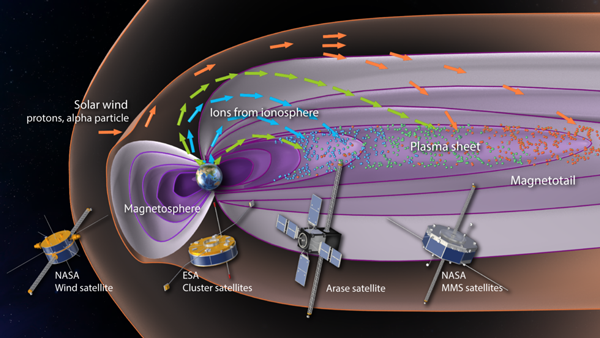Disclaimer: machine translated by DeepL which may contain errors.
Is the Influence of the Earth's Atmosphere on the Magnetosphere More Than Expected?
Kunihiro Keika (Assistant Professor, Department of Earth and Planetary Science)
Satoshi Kasahara, Associate Professor, Department of Earth and Planetary Science
In the magnetosphere (near-Earth space dominated by the Earth's magnetic field and filled with plasma), the electromagnetic field and plasma fluctuate dynamically due to the interactions with the solar wind (plasma wind from the Sun). Where did the plasma filling the magnetosphere originate from?
Most of its origin has been attributed to the solar wind, but this research has revealed that the plasma from the Earth's atmosphere fills the magnetosphere when solar activity is high and magnetic storms occur.
This study will elucidate the interactions between the solar wind and planetary magnetic fields, as well as planetary atmospheric outflows into space and the role of planetary magnetic fields in planetary systems.
![]()
At the top of the Earth's atmosphere (the region in contact with space), there is the ionosphere, where the Earth's atmosphere and plasma (ionized atoms and molecules) coexist. At higher altitudes, there is the magnetosphere, where plasma is dominant (purple region in the figure). The magnetosphere is a region where the Earth's magnetic field blocks the solar wind (high-speed plasma wind blowing from the Sun). The magnetosphere extends to more than 10 times the Earth's radius. The magnetosphere cannot completely block the solar wind on the night side, which is in the opposite direction to the sun (right side of the figure), so plasma from the Earth's atmosphere and solar wind coexist in the magnetosphere (the former is shown in green and light blue, the latter in orange in the figure).
The coexistence of plasmas of different origins and associated physical processes (e.g., solar wind entry into the magnetosphere, the outflow of Earth's atmospheric plasma into the magnetosphere, etc.) have been unsolved problems and extensively studied for many years. The magnetosphere is electromagnetically coupled to the solar wind, and the interaction with the solar wind dominates the spatiotemporal variations (dynamics) of magnetospheric plasma. It was understood that most of the magnetospheric plasma originates from the solar wind and that the Earth's atmospheric plasma, especially singly-charged oxygen ions, increases only when the Sun is highly active and magnetic storms occur. Contrary to this view, the present study, based on precise ion species observations and internationally coordinated observations by multiple satellite missions, has revealed that the magnetospheric plasma, both oxygen and hydrogen ions, predominantly originates from the Earth's atmospheric plasma during magnetic storms.
Hydrogen ions are singly charged in the solar wind and the Earth's atmosphere, making it impossible to distinguish their origins. On the other hand, heavier ions are highly charged (He++, O6+, etc.) in solar wind plasmas and singly/doubly charged (He+, O+, O++, etc.) in Earth atmospheric plasmas, so their origins can be distinguished. In this study, we have accurately separated He+ and He++ (denoted as alpha particles in the figure) based on observations by mass spectrometers, led by the LEP-i and MEP-i particle detectors on board the Arase satellite. The successful mass determination has made it possible to treat He+ as a tracer of Earth atmospheric plasmas and He++ as a tracer of solar wind plasmas. Although it is difficult to constantly observe the solar wind and magnetosphere with a single satellite, we succeeded in clearly observing the temporal variations of the origin of magnetospheric plasma over several days throughout a magnetic storm, by using simultaneous collaborative observations with multiple satellites (see figure).
 The arrival of the plasma in the magnetosphere is shown in orange for solar wind plasma and in green and light blue for Earth's atmosphere plasma. Light blue indicates low-energy Earth's atmosphere plasma, and green indicates slightly higher-energy Earth's atmosphere plasma. Earth's atmospheric plasma flows out from a wide area around the poles, and the energy at the time of outflow varies. Depending on the location and energy of the outflow, the transport path and reach to the magnetosphere are different. The relative contribution to the overall magnetospheric dynamics is also thought to differ, but the relative contribution is not yet understood.
The arrival of the plasma in the magnetosphere is shown in orange for solar wind plasma and in green and light blue for Earth's atmosphere plasma. Light blue indicates low-energy Earth's atmosphere plasma, and green indicates slightly higher-energy Earth's atmosphere plasma. Earth's atmospheric plasma flows out from a wide area around the poles, and the energy at the time of outflow varies. Depending on the location and energy of the outflow, the transport path and reach to the magnetosphere are different. The relative contribution to the overall magnetospheric dynamics is also thought to differ, but the relative contribution is not yet understood.
This study has significantly changed the conventional view of plasma dynamics in the Earth's magnetosphere, specifically the outflow of Earth's atmospheric plasma into space and its circulation within the magnetospheric system. It is also expected to provide clues to the universality and diversity of the electromagnetic couplings and interactions with the solar wind and the effects of planetary and satellite atmospheric plasmas on the magnetospheric system.
This work was published in L. Kistler et al. Nature Communications, 14, 6143 (2023).
(Press release, October 30, 2023)
Published in The Rigaku-bu News, March 2024
Frontiers of Science for Undergraduates >


